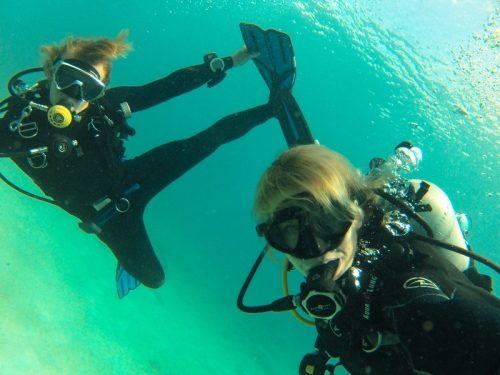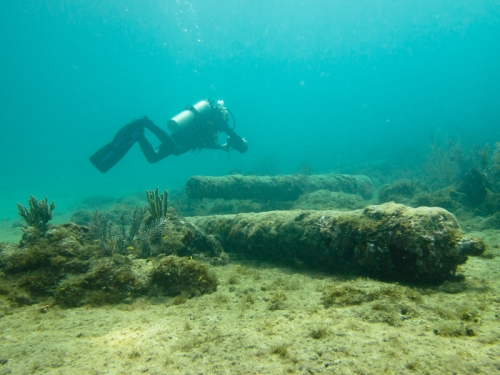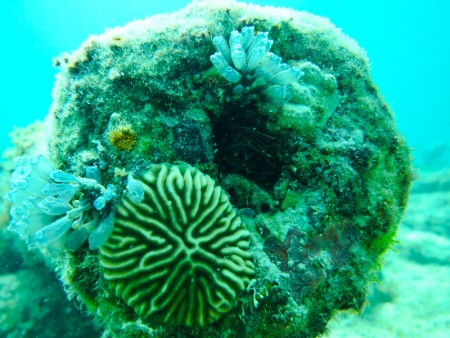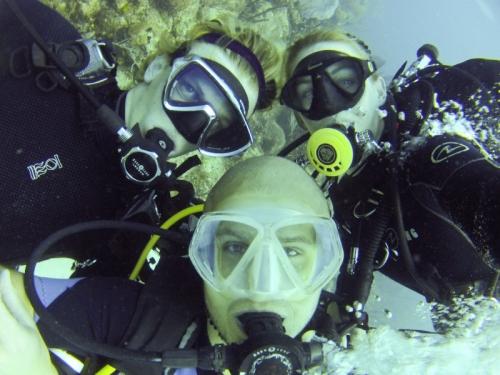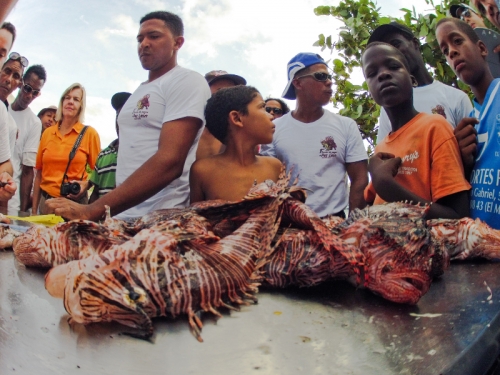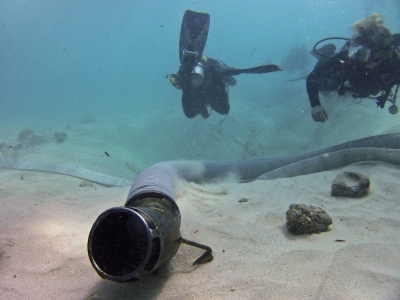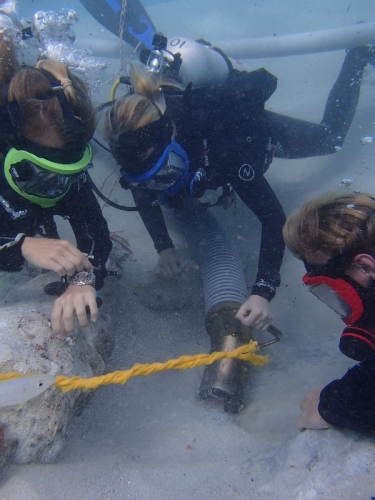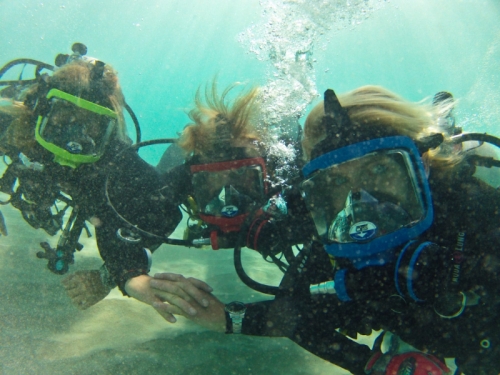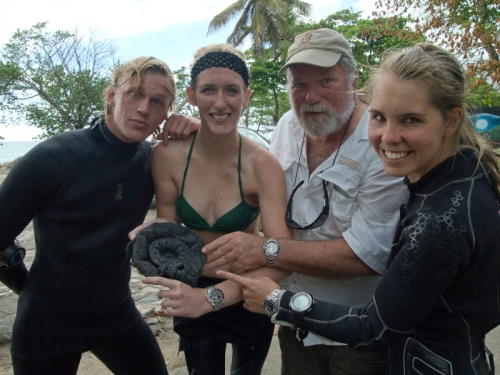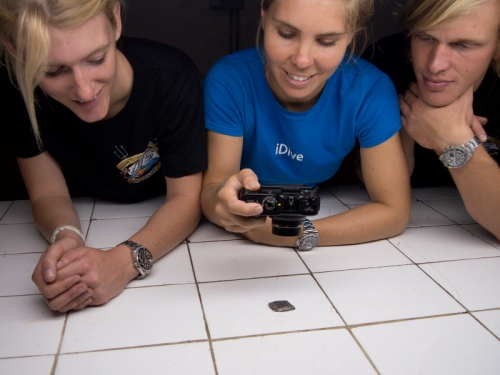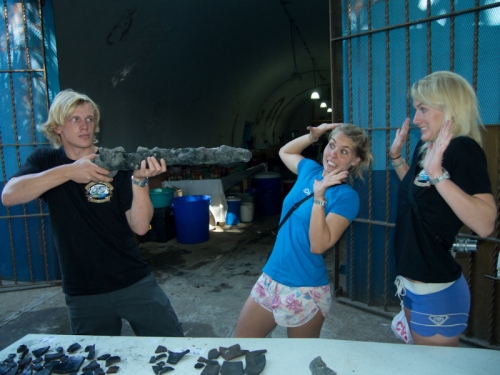Scholars are all about teamwork! Thank you to Oscar for writing this awesome blog about our time together being archaeologists in the Dominican Republic.
After the cold and dark waters of North Carolina, Megan and I boarded planes headed for the Dominican Republic.
We were going to work with Dr. Charlie Beeker from Indiana University on an excavation of Senora la Nuestra de Begona, a wreckage site from 1725. Charles has been working towards raising awareness of historical sites along the Dominican coast for many years. He has chosen awareness as his tool. His long career catalogs success establishing underwater parks for preservation and education which display authentic archaeological pieces like cannons and anchors for divers to see.
Founding Los Museos Viveos del Mar- Living Museums of the Sea, Charlie is partnering with government officials to ensure history is protected, preserved, and used for the benefit of all rather than auctioned the highest bidder. Artifacts under the sea represent an important cultural heritage for the places they reside and the era they explain. An added global benefit is museum sites are off-limits to fisherman creating biological havens along with cultural ones.
In the Dominican Republic, wrecks are plentiful. Many treasure hunting organizations have gathered to search for valuable cargo buried deep in the sand together with the ships that carried them. Indiana University provides an alternative to the treasure hunters in finding and preserving the history of the island.
Megan and I met up with Rodrigo, the Museum’s in-country coordinator and a Peace Corp volunteer. Rodrigo hosted us for two days on the southern coast in Bajahibe diving several of the underwater museums. The sites fit carefully into the surrounding reefs and are labeled so anyone underwater can enjoy the history surrounding them. Thank you to Rodrigo and our host diver center ScubaFun for spending the days getting us habituated into Dominican life.
In Bajahibe, we also were able to join the first ever lionfish tournament for the region. There were over 800 fish brought in by spearfishermen and scuba divers. Lionfish are native to the Pacific and have exploded across the Caribbean after being wrongly introduced. A single lionfish can eat 80% of the juvenile fish on a small coral reef in only five weeks. The invasion means serious trouble for already damaged reefs in the Atlantic. It’s encouraging to see a town come together to do something proactive for the health of their ocean.
After a few days we proceeded to the capital, Santo Domingo, where we met up with the team from Indiana and Yolly, our Australian scholar. The work could begin on the site of merchant ship Senora la nuestra de Begona. In 1725, she was transporting goods (and contraband silver) trying to avoid the authorities when she started to take on water. Several days of effort were made to try to save her while a massive storm developed offshore. Sailing up and down the coast they realize they would have to either be smashed upon the cliffs or run her aground on the only available strip of beach. Once plowed into the surf and sand, efforts to salvage as much precious cargo as possible were attempted but in the hard weather much of it was lost between the ship and shore. Amazingly, no souls were lost as the storm battered the ship apart. Finally she went under and the captain was forced to face authorities for misrepresenting the purpose of his mission. He was charged with crimes against the Spanish crown and the historical story in records goes cold before his sentencing. No serious efforts were ever made to return for all that was lost.
Indiana University had returned for the Begona. We concentrated our work near shore where the lost items had fallen during rescue attempts and settled into a sandy bottom- buried for nearly three hundred years. With metal detectors, different hotspots where found that could be used as starting places for dredging.
Charlie and his team had made exciting discoveries here like talegas (bags of silver coins), dinnerware, candlesticks and even a cannon. They were thrilled to be back to search for more artifacts. Shortly we were put to work with dredging sand, because As Charlie said, “it’s all out there. You just need to move a lot of sand!”
To aid us working underwater we each wore Guardian full face masks fitted with Buddy phone communication systems from Ocean Technology Systems. OTS was kind enough to come to DR to train us in the use of the masks and communication systems which proved valuable when working together underwater.
Conveying messages like “Megan, would you come over here and dig just a little bit on this side of the cannon but no more than about two centimeters and go slowly” or “ Yolly, could you swim over to the exhaust and check what has happened to the dredge? I think I’ve blocked it with a rock or two” is somewhat beyond my sign language skills.
When we slowly started to find artifacts, there was no stopping us! Each shift we nearly had to be dragged out of the water when it was time for the next team to take over. The dredge was powered on nonstop from morning to afternoon with a rotating circuit of divers underwater. Significant efforts were rewarded by bringing up amazing piece after amazing piece.
We uncovered everything from pre-European contact Tai’no pottery, to silver candlesticks, even an ornate sword hilt and musket. I soon learned to appreciate the trained eyes of the archeologists who could spot a centimeter size piece of pottery when moving literary tons of sand at high speed. As if that’s not enough lightning speed dart hands could catch it before it was sucked up the dredge. We all had our go at hanging on to the high power dredge while being thrown around in the surge, which made for some very interesting dives.
Each and every item that was brought ashore was documented carefully, photographed and numbered before being carried to the lab for further work. The detective work of puzzling out each artifact is fascinating. This small piece which started off looking only like scarp metal turned out being a silver coin traceable back to a mint in Mexico City 1700!
All of the objects are the property of the Dominican government. Some artifacts are loaned to Indiana for study and preservation, but that needs lots of paperwork and help from the right people. These permissions are not always the easiest thing to gain but Charlie and his team doesn’t let this stop them.
After a time filled with both fun and hard work we left the DR behind for new adventures and having learnt something completely new to us all. Thank you very much to Charlie Beeker and Indiana University for welcoming all three scholars together. We truly enjoyed earning our ‘Junior-archaeologist’ badges.
Where I went you will soon find out but it wasn’t too far…
